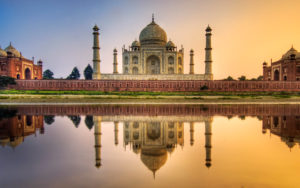 Indian heritage is experiencing an aesthetic and intellectual revolution. With financial
Indian heritage is experiencing an aesthetic and intellectual revolution. With financial
and intellectual investment as well as political will, cities are likely to improve their
heritage sites through retrofitting and conservation initiatives.
India has been blessed with many heritage monuments. Right from the Great Bath at Mohenjo-Daro to Taj Mahal in Agra, India has many monuments built by rich and powerful patrons of art and culture. The fact that these have stood the test of time proves without doubt the remarkable craftsmanship and intellect behind their creation. At present, these monuments haven’t been maintained in a manner such that befits their status as works of art. Nevertheless, institutions such as Archaeological Survey of India (ASI), Aga Khan Foundation (AKF), Indian Space Research Organisation (ISRO) and others have done their bit to ensure that these works of architecture stay pristine and beautiful.
The aspects of HRIDAY
The Ministry of Urban Development (MoUD) is working with ISRO to ensure that smart cities in India are not built at the cost of compromising cultural and natural heritage sites, a crucial component of HRIDAY. For this Geospatial Technology (GST) will be used to effectively map such sites. Union Urban Development Minister M Venkaiah Naidu says, “GST makes use of satellite navigation systems and computer databases called the Geographical Information System (GIS) to create, capture, store and retrieve geographic and spatial information of any place. The use of GST-based mapping of cultural and natural heritage assets to increase its viability is central to achieving the main objective of HRIDAY scheme.”
Under HRIDAY the MoUD approved development of a 6-km long Dwarka Darshan Circuit in Gujarat at a cost of Rs 16.27 cr. The works to be taken up include development of streets and pedestrian pathways, laying of cycle tracks, provision of benches, resting spaces, changing rooms, drinking water and toilet facilities, craft and food bazaar, signages, LED lighting, plazas for vending spaces etc. This would make the place, as the MoUD says, an active cultural and interactive hub.
Restoration and repair works
Archaeological Survey of India (ASI) is the nodal agency to maintain and restore heritage sites in India. Recently, the ASI carried out the preservation work of the Jonnagiri Rock Edict in Kurnool district, which dates back to the 3rd century BC. Jonnagiri is one such edict that was built under Mauryan emperor Ashoka’s rule. It is located in the Pattikonda mandal of Kurnool district and contains inscriptions written in Brahmi script. K Krishna Chaitanya deputy director, ASI, says, “For 2,300 years, this edict was left to the vagaries of nature. Now we are making use of technology to preserve it and restore it to its pristine glory. It is the world’s first rock edict with inscriptions that preach love for wildlife. An amount of Rs 6 lakh had been sanctioned by the Government of India for the current year, to carry out structural restoration work.” In order to make the Brahmi writings more intelligible, ASI will provide gist boards at the site. A gist board is a reference tool where every letter of the Brahmi script is transliterated into Telugu and Hindi, and the equivalent grammatical connotations are juxtaposed so that the common public may understand and appreciate the text. A pavilion has also been constructed to protect the edict.
The Aga Khan Foundation (AKF) has also done its bit to protect the monuments in Delhi. Earlier, the Sundar Burj in the Nizamuddin area had a dilapidated look and was defaced with graffiti scrawls. The Aga Khan Trust for Culture (AKTC) under the AKF took up the restoration work and restored the Burj to its original pristine state. The AKTC is working in collaboration with government agencies as part of the Nizamuddin Urban Renewal Initiative.
The trust’s noteworthy accomplishment has been the restoration of Humayun’s Tomb in 2013. Over a period of 10 years, the tomb was restored to its earlier avatar. Conservation architect Ratish Nanda, CEO, AKTC, says, “The AKTC’s objective is to enhance the life of the buildings by removing modern materials like cement that have been added to them over the decades, and, wherever possible, restore the missing elements with original materials and design. In the case of the Humayun’s Tomb, the design of the ASI was faulty and had compromised the structural integrity of the monument.”
Ultimately, protecting and preserving works of art must become every Indian’s responsibility. That responsibility can be aroused when all stakeholders right from lawmakers, bureaucrats and civil society to the common Indian see monuments as extensions of their own identity and look upon any damage to the monument as a threat to their own existence.
